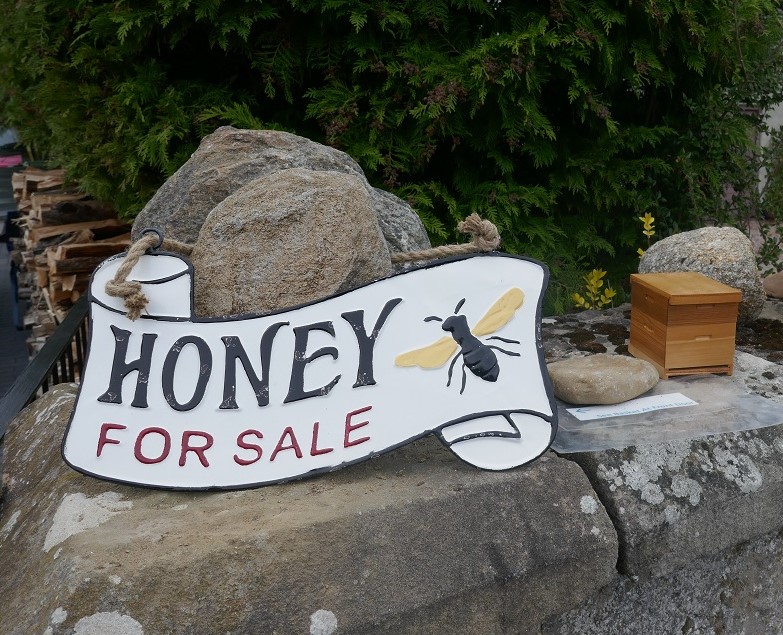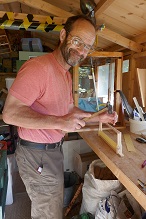
Harvesting Oil Seed Rape Crop.
Three weeks of gloriously warm and sunny weather ended abruptly last Tuesday. The temperature almost halved and it felt really chilly around 10-12 degrees Celsius. This coincided with the all the local oil seed rape (Brassica napus) fields turning green. Definitely time to harvest honey before it set solid on the combs. The high glucose content and fine crystals mean that when the honey cools it form a spoon-bending solid matrix of crystals. Luckily, Monday June 1st was warm so I set to work clearing supers and extracting honey.
Soft-Set Honey.

I was so impressed by Andrew Abrahams’ classy jars (https://colonsay.org.uk/) when I visited him on Colonsay last summer that I ordered up new jars with matte finish lids and clear tamper evident labels.
Before bottling the honey, I let it settle for a couple of days before removing the froth from the surface of the bucket. Then Linton used a special paddle attached to an ordinary DIY type drill (dedicated to honey processing) to break down the fine crystals. This took about 10 minutes.


Care is needed not to introduce air into the honey so the paddle is placed well below the surface of the honey, but not far enough down to touch the bottom or sides of the plastic food grade bucket. By this stage the honey is thickening rapidly but still moveable and we transfer it into a tank with tap for bottling after another couple of days of settling to let bubbles rise to the surface. Only one bucket (25lbs) is processed at a time as I let the rest set solid in buckets and store it till required. At this later point, I scrape the surface of the solid honey then gradually warm bucket in the honey warming cabinet for a couple of days at 32 degrees Celsius. When it becomes the consistency of porridge, we break down the fine crystals with the paddle. There are several ways to skin a cat and some people seed soft-set honey with 10% honey, like OSR or clover that also sets with a fine grain crystal, but we never do and it works well for us. It spreads like lard.


Marketing.
I’d received honey orders from regular customers so I filled them first then placed a basket at the front door. I’m not sure how that will work this year with Covid-19 restrictions still in place but a regular customer drove out from town yesterday for some. We chatted at a distance in the back apiary, then later the traveling fish van saleswoman asked to buy some to sell on. Marna’s family’s vans travel from the east coast over to the west so it will be interesting to see how sales go there.
June Forage.
So, what next for the bees after the abrupt halt to the lucrative nectar flow?

As if on cue the gum tree started flowering. I noticed the noise of pollinators in the tree first.


It wasn’t long before both exotically perfumed thyme beds were twitching and buzzing with both honey bees and bumble bees so I relaxed a bit. I noticed white clover which seems a little early but the best bit is this field left like a meadow.


Just across the road from the apiary is this redundant field normally mown to the bone, for some unknown reason, by Cawdor Estates. However, the bees have lucked in in lockdown and it is now a profitable wildflower meadow and humming with pollinator activity.
Swarms.
The swarm from the garden bait hive is doing well and sublimation with oxalic acid produced only 1 dead varroa which was interesting.

Our Nairn beekeeper friend Cynthia was in luck this year with the arrival of 2 swarms into her garden. One was a small after- swarm or cast that arrived before 3 days of rain and huddled up in this tree till Linton rescued them when the sun came out. It was rather a difficult location and needed 3 attempts to get the bees into the skep from the tree branch, but then we saw the virgin queen on the front of the nuc. After a bit of encouragement to enter, she was followed by the stragglers fairly promptly.

What Next?



The plan is produce cut comb next and so strips of foundation are inserted into the frames by Linton. The foundation has been produced by Fred Mollison from our own varroacide -free wax. The bees are given a wee boost of sugar syrup to encourage and assist with wax production.
Just in Time.
I’ve managed to farm out some of the fiddly bee work in the nick of time for both my assistants are now off furlough and back in the skies.

You are so well organised, Ann. It is lovely to see. Thank you for sharing all this with us – it is inspiring. x
Well thank you, Margaret Anne. I’m currently increasing the apiary (max 15 colonies) so need to be more efficient. I’m glad if my post help others in some way.